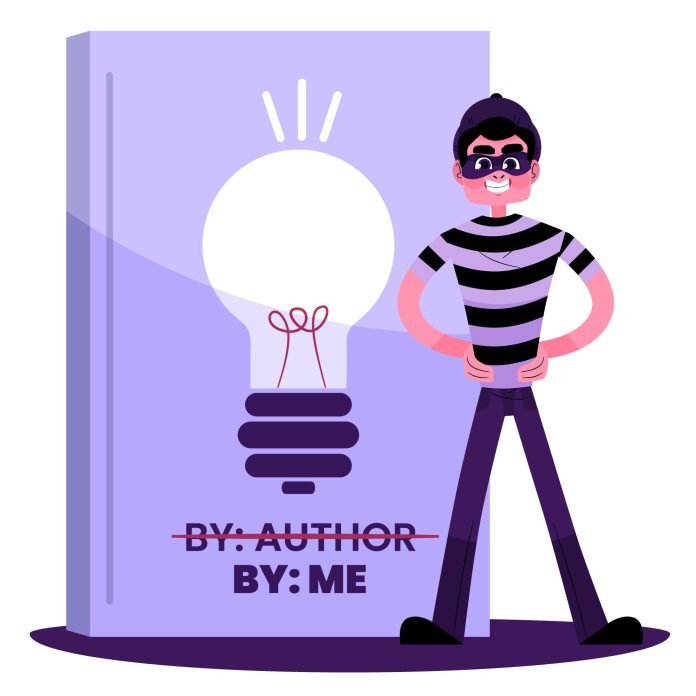‘Plagiaris’ literally means ‘to kidnap.’ So, if we were to define plagiarism, the best way to put it would be as the stealing of intellectual property across various platforms. We’ve all witnessed this phenomenon at some point in our lives, haven’t we? Another term that we’ve come across in this context is ‘copyright infringement.’ Let’s not get confused. They’re not the same. It’ll clear up once we get into how the latter takes place. Copyright protection acts as a means to protect one’s intellectual work, with the help of the law. Instances of someone using the work of another person without giving due credit, especially when its complete rights belong to the original owner, can lead to a lawsuit. Hence, the attempt to pass off someone else’s work as their own, without any reference or citing a secondary source, qualifies as copyright infringement.
In the event of plagiarism occurring, the original creator can call out the offender, but that is as far as they can go. The lack of copyright protection doesn’t guarantee that much of a consequence, let alone taking the offender to court or leading to punishment by law on ethical grounds. Also, plagiarism takes place in several ways. Let’s see how.
* Direct plagiarism refers to the act of directly lifting portions of an original work without paraphrasing or modifying any of it. Since works that are in the public domain, due to their copyrights getting expired over the years or for other reasons, are no longer copyright protected or have any intellectual property law rights applied, those are available for the public to draw inspiration from, represent in their way, and build on. Of course, there are elaborate guidelines to classify what falls under the public domain, and that’s a discussion for another time.
* Complete Plagiarism, on the other hand, is the act of stealing the entire content from elsewhere, right from the beginning to the end, and eventually gets republished under someone’s name who is in no way the original creator of it.
* Self-plagiarism, or auto-plagiarism, is another addition to this list, wherein a person resubmits their work created for a previous occasion. There’s no acknowledgment that they’re resubmitting it. It could either be due to a lack of desire to work as hard again or overestimating oneself, which is perhaps reflected in the dishonest attitude. Say, the same paper may be sent to another journal without accepting the fact that it’s already been published once. This, right here, is a fabrication of truth. Wanting to generate a lot of content could also be a driving factor.
* Mosaic plagiarism, or patchwork plagiarism, is the practice of lifting words, phrases, and ideas and stitching them in a completely different context or portion to make it look like a coincidence. Just as a mosaic comprises small parts of different elements, making up a pattern or a patchwork design emerges from sewing together pieces of different fabrics.
* Paraphrase Plagiarism, as the name suggests, involves changing words or the context to violate the actual sequence of the source material. Not writing it verbatim doesn’t take away from the fact that they’re manipulating readers’ minds. Retaining the meaning or implication, but with a tweak, can be hard for even AI to catch.
*Source-related plagiarism constitutes stealing sources from the original creator of a work. Understanding this will be easier with an example. When one quotes from author A, instead of admitting that, they credit another author, B, who they find in A’s references. It goes beyond this. Copy-pasting bibliographies and inserting a non-functional URL are all ways of misrepresenting facts.
* Accidental plagiarism is a case of genuinely missing references while citing them. Even after having the content for the bibliography or reference names, when quotations, footnotes, the author’s name, or other parts of it don’t show up in the final work, that falls under this category. It is unintended, unlike the other types discussed previously. To avoid this, careful planning and time management are a must.
It is only normal that we read to gain clarity, to learn more about something, and to improve our understanding. So, our reference material getting a mention within our work, wherever applicable, backs the fact that we engaged in research. When it finds a place in our creations, it upholds a sense of integrity, which itself is a great virtue.
It is increasingly necessary for us to know what counts as plagiarism or copyright infringement, get our facts right about public domain works, stay mindful of what we generate and how we do so, and above all, be respectful towards other works that aid our process.






























